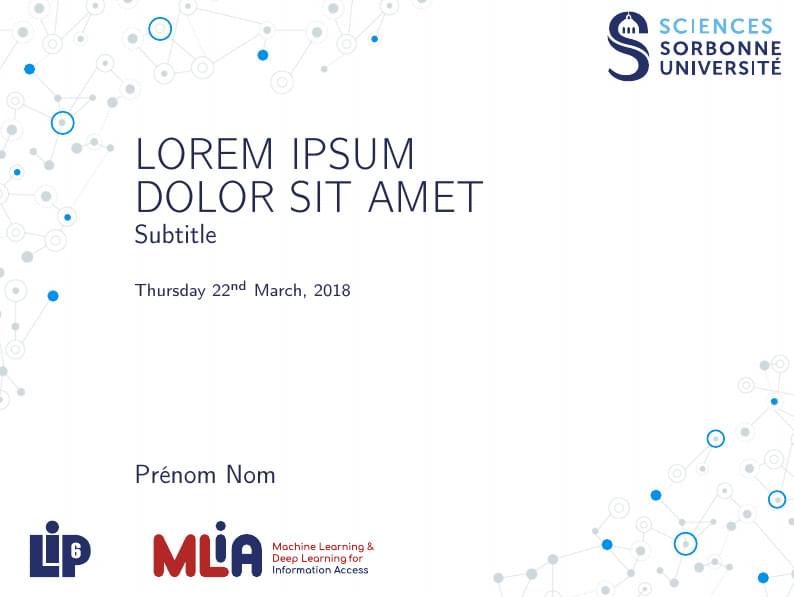
Présentation Sorbonne Université
Author:
Robert
Last Updated:
6 years ago
License:
Creative Commons CC BY 4.0
Abstract:
Template Sorbonne Universite

\begin
Discover why over 20 million people worldwide trust Overleaf with their work.
Template Sorbonne Universite

\begin
Discover why over 20 million people worldwide trust Overleaf with their work.
\documentclass[compress,xcolor=table]{beamer}
% Packages
\usepackage[english]{babel}
\usepackage[utf8]{inputenc}
\usepackage[T1]{fontenc}
\usepackage{datetime}
% Possible options of the package (add/remove below in \usetheme call):
% - nosectionpages: no pages between sections
% - flama: use flama font, requires xelatex/lualatex + the font to compile
% - compressminiframes: put the heading list bullets indications pages on 1 line
\usetheme[compressminiframes]{sorbonne}
% Title page
\title{Lorem Ipsum \newline Dolor Sit Amet}
\foottitle{Lorem Ipsum Dolor Sit Amet} % optional, printed at the bottom of the slides, by default same as title, can be useful to rewrite when title has a newline for example
\subtitle{Subtitle} % optional subtitle
\date{\formatdate{22}{03}{2018}}
\author{Prénom Nom}
% \institute{LIP6 - Sorbonne Université} % Optional
% Biblatex
\usepackage[backend=bibtex, style=authoryear, citestyle=authoryear]{biblatex}
\bibliography{library.bib}
\renewcommand*{\bibfont}{\footnotesize}
%%%%
%% BEGIN OF SLIDES
%%%%
\begin{document}
\begin{frame}[plain]
\titlepage
\setcounter{framenumber}{0}
\end{frame}
\section{Noise filtering in UPMC Food-101} \subsection{}
\begin{frame}{Principle}
\begin{alertblock}{The problem}
\begin{itemize}
\item
UPMC Food-101 has been crawled from Google Images
\item
It contains a certain amount of noise
\end{itemize}
\end{alertblock}
\begin{block}{The idea}
\begin{itemize}
\item
Creating bags from images of 1 class (e.g.~pizza)
\item
Creating bags for ``rest'' class
\item
Defining the expected level of noise in the pizza bags
\item
Using \emph{Learning with Label Proportions} models to detect noise
\end{itemize}
\end{block}
\end{frame}
\begin{frame}{Experimentations}
\begin{block}{Protocol}
\begin{itemize}
\item
\textbf{Dataset:}
\((x_i, y_i, y_i^*) \in \mathbb{R}^p \times \{-1,1\} \times \{-1,1\},\quad i=1..n\)
\begin{itemize}
\item
\(x_i\) features, \(y_i\) noisy label, \(y_i^*\) true label (not
available for training)
\end{itemize}
\item
\textbf{Create bags:} Create bags \(b_j\) of 30 points having the same
\(y_i\) and give them a proportion of positive points \(p_j\)
\item
\textbf{Training:} Train the SyMIL model on bags and train an SVM on
\((b_j, p_j)\) / \((x_i, y_i)\)
\item
\textbf{Evaluation:} Use the decision frontiers of SyMIL / SVM models
to reclassify each \(x_i\)s by predicting \(\hat{y}_i^*\), and compare
with \(y_i^*\)
\end{itemize}
\end{block}
\end{frame}
\begin{frame}{Some papers for noisy images datasets}
\begin{exampleblock}{\citetitle{Azadi2015} \cite{Azadi2015}}
\begin{itemize}
\item
Define a regularized loss for training the CNN
\item
Can be seen as looking for the label of similar images for
regularization
\item
Results slightly better than Sukhbaatar model
\end{itemize}
\end{exampleblock}
\end{frame}
\section{References} \subsection{}
\begin{frame}[allowframebreaks]{References}
\printbibliography[heading=none]
\end{frame}
\end{document}